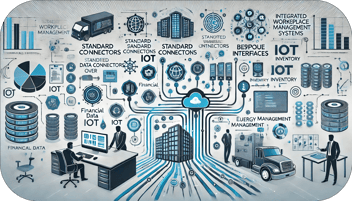In facilities management, an asset is any physical item, system, or piece of equipment essential to the operation, maintenance, and functionality of a facility. These assets range from entire buildings to individual components like plumbing systems, HVAC units, and even vehicles used for upkeep.
Proper asset management is critical to minimizing downtime, optimizing maintenance efforts, and ensuring that facilities operate efficiently and sustainably.
Table of Contents
- Types of Assets in an Integrated Workplace Management System (IWMS)
- Why Standardizing Asset Data Matters
- Criteria for Entering an Asset into an IWMS
- Conclusion
Types of Assets in an Integrated Workplace Management System (IWMS)
When entering assets into an Integrated Workplace Management System (IWMS), it’s important to consider all elements that contribute to a facility’s functionality. A well-structured asset inventory improves tracking, reporting, and long-term planning. Here are key categories of assets:
- Buildings – Entire structures that house various operations and activities.
- Systems and Subsystems – Integrated systems such as plumbing, electrical, and HVAC that support the building’s infrastructure.
- Serialized Assets – Equipment like boilers and air handlers that have unique serial numbers for identification and maintenance tracking.
- Structural Components – Elements like the foundation, walls, and roof of a building.
- IoT Transponders – Devices that collect and transmit data for monitoring and optimizing facility operations.
- Vehicles and Equipment – Maintenance vans, tractors, leaf blowers, and other tools used for facility upkeep.
Why Standardizing Asset Data Matters
For consistency across multiple facilities, assets should be tied to a recognized standard such as Uniformat II, Omniclass, and/or Masterformat.
Aligning assets with these classification systems provides key advantages, including:
- Standardized data across multiple sites – Ensures consistency in asset tracking and reporting across different locations.
- Improved facility condition assessment data collection – Helps create structured and meaningful inspection reports.
- Streamlined reporting and analysis – Supports accurate cost estimation, budgeting, and decision-making at both the individual site level and across an organization.
By incorporating Uniformat II, Omniclass and/or Masterformat, organizations can enhance asset visibility, improve forecasting accuracy, and align facility data with industry best practices.
Criteria for Entering an Asset into an IWMS
To effectively manage assets, they should be categorized based on specific criteria that define their role within facilities management:
- Maintainable – Requires regular maintenance to remain operational (HVAC systems, plumbing, electrical components). Preventive maintenance reduces unexpected failures and extends asset life.
- Regulated – Subject to compliance requirements (boilers, elevators). Proper documentation ensures safety and avoids regulatory penalties.
- Permitted – Requires specific permits for operation (specialized machinery). Ensuring compliance reduces legal risks.
- Tracked – Needs ongoing monitoring for usage, location, and condition (vehicles, maintenance equipment, IoT devices). Improves utilization and availability.
- Counted – Regularly inventoried items (tools, spare parts, consumables). Helps maintain accurate inventory levels and reduces shortages.
- Metered – Assets with measurable usage metrics (utility meters, operational logs). Supports efficiency tracking and cost management.
- Critical – Essential to facility operations (emergency systems, backup generators). Ensuring reliability prevents disruptions.
Conclusion
Effective asset management is key to operational efficiency, cost control, and long-term sustainability.
By categorizing assets based on their maintenance needs, regulatory requirements, tracking parameters, and operational importance, organizations gain a structured approach to facilities management.
Additionally, standardizing asset classification enhances data integrity, simplifies facility condition assessments, and improves reporting and analytics.
With a clear, strategic approach, facilities teams can reduce risk, minimize costs, and maximize the long-term value of their assets.
Would you like to learn more?
Related Resources:
- Facilities Management Overview
- What is the Best IWMS Software for Government?
- The State of Alaska Tackles Statewide Deferred Maintenance
- Why Capital Budgeting Software is Critical in Government Facilities
- Three Keys to Effective Space Management
- Facilities System Integration
- FacilityForce's IWMS Solution




